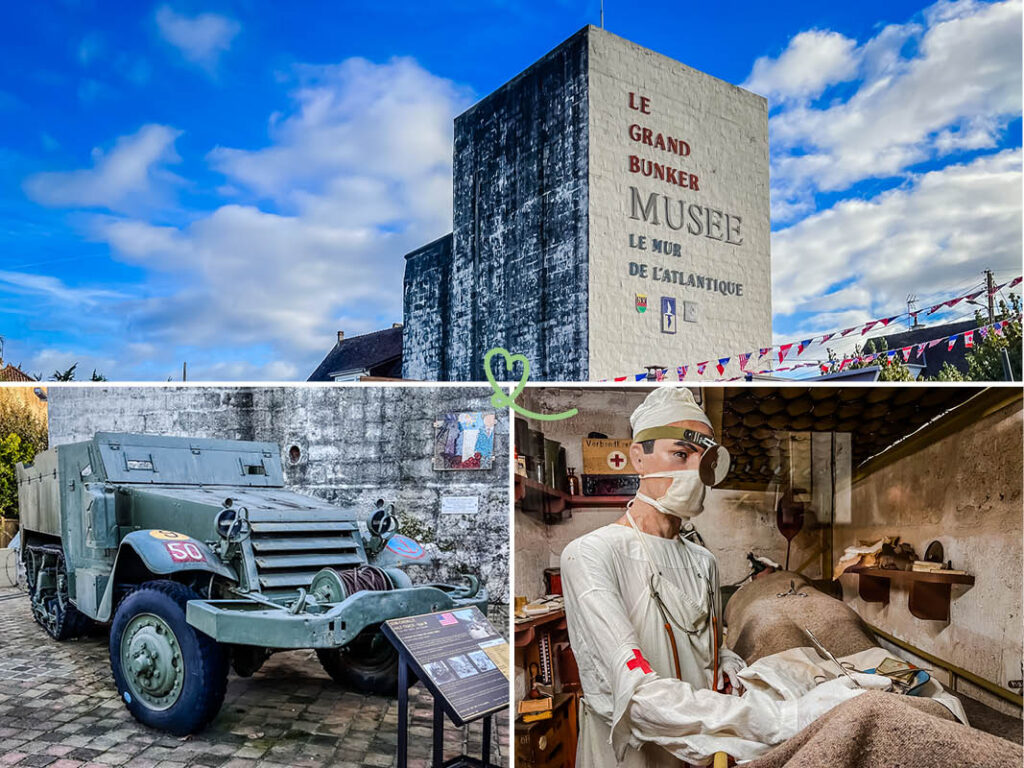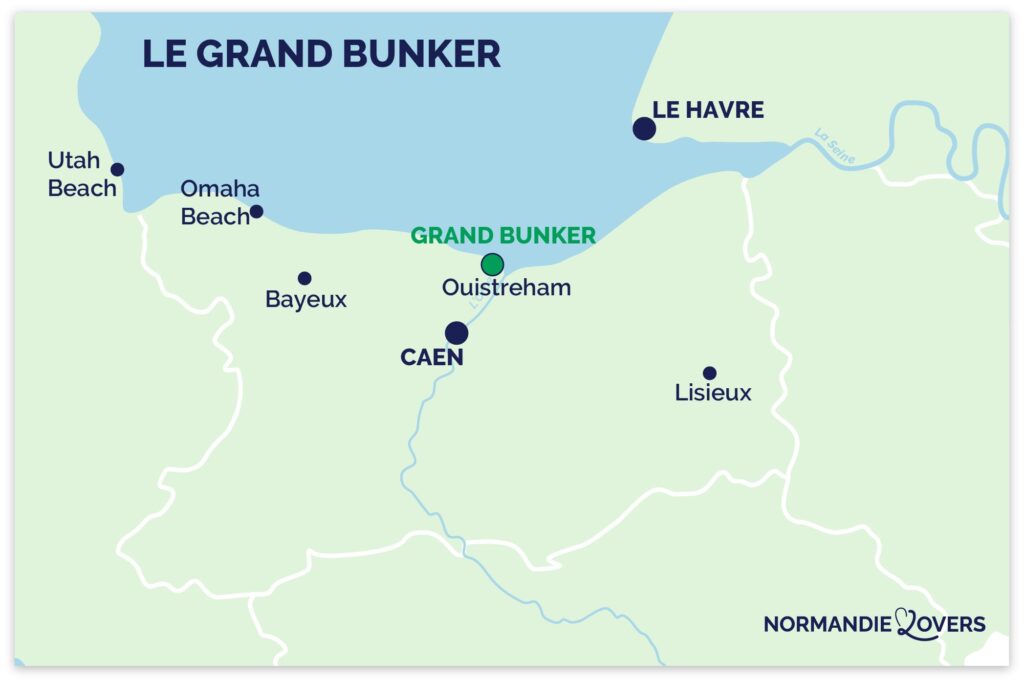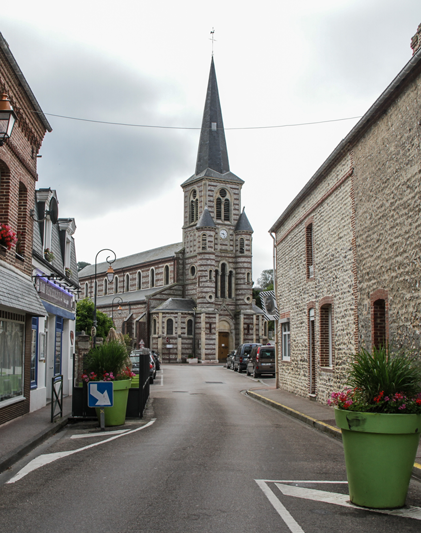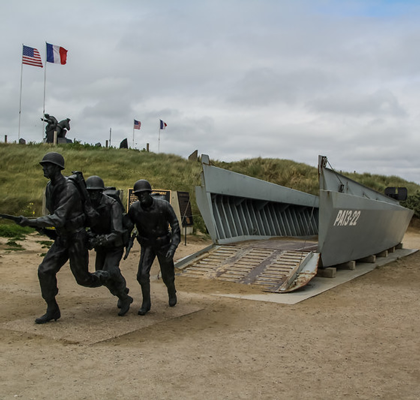If you’re touring the D-Day landing beaches, don’t miss a visit to the Grand Bunker, a former Axis command and fire post at Ouistreham dating back to the Second World War. Now fully renovated, the bunker houses the Atlantic Wall Museum and recounts the lives of German soldiers at the time.
Find all our tips in this article to facilitate your visit to the museum.

This review is completely independent, we visited anonymously and paid our admission in full.
Why visit Le Grand Bunker in Ouistreham?
Is the Grand Bunker worth a visit? In our opinion:
Yes, completely, because the museum of the Atlantic Wall is one of the rare authentic “blockhouses” preserved in France.
Passionate about the history of D-Day, the founders and owners of the museum, Fabrice and Brigitte Corbin, have done a remarkable work of memory to retrace the history of the Atlantic Wall and the daily life of German soldiers until D-Day on June 6, 1944.
This museum remains a must if you are visiting Ouistreham, the starting point for discovering the D-Day beaches.

Why is it famous?
The centerpiece of the Atlantic Wall (or Atlantikwall in German), the Great Bunker is one of the many fortifications built under Adolf Hitler’s authority to prevent an Allied invasion during the Second World War. These fortifications were to stretch from the northern coast of Norway to the south of France. The D-Day landings and subsequent battles marked the end of this massive military project launched by the Third Reich in March 1942.
Considered as one of the high places of the D-Day landings, this former German HQ represented a strategic decision post during the conflicts.
The staging, with the attention to detail, in each room are really very realistic, we can completely imagine the life of soldiers in the bunker!
So, are you ready for a total immersion in the reality of the front?

Practical tips and map: Museum of the Atlantic Wall
Where is Le Grand Bunker/Atlantic Wall Museum located?
The museum is located in Normandy, not far from the city of Caen, in the town of Ouistreham, at 6 Avenue du 6 juin.
- Driving time from Caen: 25min.
- Driving time from Le Havre: 1h25.
- Driving time from Deauville: 50min.
- Driving time from Bayreux: 45min.
- Driving time from Paris: 3 hours.
- Driving time from Evreux: 2 hours.
Here is a map to help you find your way:

OUR ADVICE FOR RENTING A CAR IN Normandy
- Compare prices on our preferred platform: DiscoverCars – one of the best rated sites.
- Choose a car that is comfortable enough (distances can be long) but compact (some parking lots and villages are narrow).
- Think of thecomplete insurance (some roads are tortuous and narrow).
- There is a lot of demand, book it early.

How to get there
The museum, located on Avenue du 6 juin, 14450 Ouistreham, is not easily accessible by public transport. It’s best to come to Ouistreham by car.
This Norman city is easily accessible from Caen and Bayeux with the D-Day beaches, or from Deauville.
The museum is not located in the city center, but you only have to walk 10 minutes from the Casino de Ouistreham to get there.
If you don’t want to drive, you can opt for the Twisto bus from Caen, which will take 30min to reach the museum.
Or you can choose private tours from Bayeux, Caen or Paris that include this museum, with perhaps the Pegasus Bridge located in the same city – see options and availability.
Parking
Paid parking is available on the seafront and in the central part of Place de Gaulle, and on the port from April 1 to September 30 inclusive, Monday to Sunday, 9am to 7pm. From October to March, parking is free in these areas.
Outside these zones, parking is free all year round.
Near the museum, you can also park along the road or go to the parking lots near the Casino, still a 10-minute walk from the Grand Bunker.

Best time to visit Le Grand Bunker
There is no particular time to visit this historic site. It can be very busy in high season. To get the most out of your visit to this busy museum with its narrow passageways, and if possible, opt for the low season between October and March.
Visit the Atlantic Wall Museum: tips
To discover this old bunker, to face its numerous stairs and why not (for the most daring) to climb on the terrace, put on good shoes and comfortable clothes!
Unfortunately, the visit of the museum is not adapted to people with disabilities or in wheelchairs.
Finally, your pet will be accepted on the museum premises. If it’s a large animal, it’s best to visit the museum between 9 and 11 a.m. from April 1 to September 30.
USE OUR GUIDE TO PLAN A
DREAM TRIP TO Normandy
All the information you need for your trip:
- 8 maps that make planning easier
- 160+ pre-selected locations
- Practical advice
- 300+ photos to help you choose

How long to visit the museum and main difficulties
Allow 1 to 2 hours for your visit, depending on your interest in the information presented and the different levels of the museum you wish to visit.
As mentioned above, the Grand Bunker is full of staircases, and some rooms are somewhat cramped. If you don’t like enclosed spaces, or suffer from claustrophobia, you’d be best advised to visit during very low-traffic periods.

Schedules and prices
- From February 5 to March 31: 10 am to 6 pm (last entry at 5 pm).
- From April 1 to September 30: 9am to 7pm (last entry at 6pm).
- From October 1 to November 13: 10 am to 6 pm (last entry at 5 pm).
- From November 14 to December 16: Open only on weekends, from 10am to 6pm (last entry at 5pm).
- From December 17 to January 2: 10am to 6pm (last entry at 5pm).
Each year, the Atlantic Wall Museum closes from January 3 to February 4 and on holidays (December 25 and January 1).
Remember to check the official website to see if the schedules have been updated before your visit to the museum.
Find the details of the rates here:
- Full price for adults and children over 13: 8 €.
- Reduced rate for children from 6 to 12 years old: 6 €.
- Free for children under 6 years old.
Restaurants
Make sure you have something to nibble on before your visit to the museum, as there are no snacks or restaurants at the museum. However, there is a wide choice of restaurants in and around Ouistreham.
We recommend..:
- Restaurant La Table d’Hôtes, a gastronomic jewel to make your taste buds travel between land and sea.
- Restaurant Les Cabines, a generous cuisine for gourmets in a warm setting.
Subscribe to our Newsletter
- Get away from it all with Region Lovers’ beautiful destinations!
- Once a month
- Advertising-free
Le Grand Bunker with children
The museum’s staging, costumes and machines will delight young and old alike. Explanations of the objects and mannequins on display are highly educational, providing a different way of understanding the Second World War.
We also like the labyrinthine aspect of the Great Bunker which amuses the children!
Don’t forget that there are lots of stairs inside the museum. If you’re going there with small children, opt for the baby carrier rather than the stroller if your little ones are feeling tired!
Lodgings in the vicinity
You will find a good supply of hotels and rentals in the town of Ouistreham.
We recommend the Best Western La Mare Ô Poissons for its relaxed style – see rates, photos and availability.
STAYING NEAR THE D-Day beaches
Option 1: Bayeux
The most practical option, in our opinion, is to base ourselves in the town of Bayeux. We recommend..:
- Hotel Domaine de Bayeux in an 18th century mansion – see prices, photos and availability
- see all top rated accommodations in Bayeux

Option 2: in the countryside
In the countryside around the D-Day beaches, you will find beautiful buildings with a lot of charm: farms, manors…
- Hotel Domaine d’Utah Beach – prices, pictures and availability
- Hotel Ferme de la Rançonnière – prices, pictures and availability

Option 3: next to one of the beaches
If you’re looking for a seaside holiday or are fascinated by one of the beaches, you can choose a more specific hotel:
- Hotel Villas d’Arromanches in Gold Beach Beach – prices, pictures and availability
- Hotel La Sapinière in Omaha Beach Beach – prices, pictures and availability

An impressive 5-story bunker

This fortification was an obligatory passageway to Caen by sea from the Atlantic Ocean and was a strategic military defense post for the Germans in Ouistreham during the Second World War.
The Atlantic Wall Museum first opened its doors in June 1988. Since February 5, 2022, a number of rooms have been renovated, including the showcase of the Battle of Ouistreham.

The barge from the movie “Saving Private Ryan”, tanks and cannons
The famous PA 30-31 barge is one of the 2,800 exhibits at the Grand Bunker in Ouistreham. In 1944, it was one of the barges that helped the Allies land on the beaches of Normandy to liberate France. When you enter the courtyard, you’ll probably be transported back to the film “Saving Private Ryan”, Steven Spielberg’s war movie masterpiece starring Tom Hanks. Before being exhibited in the museum, the refurbished PA 30-31 found itself in the spotlight in 1997 on the set of this film.

The museum’s exhibits include numerous tanks, cannons and artillery arsenals. You’ll find details of Operation Overlord, which changed the course of history. This battle, fought 90 days after the Normandy landings, was the decisive step on the road to liberation.

The technical level
When we think “bunker”, we think primarily of protection and weaponry. But locked up in the middle of these windowless concrete blocks, and already caught up in the game of this visit, at no point did we think about air circulation!

In this room, you’ll discover several scenes of soldiers in action in the field, and a complete reconstruction of the ventilation and generator systems that brought these gas-tight concrete bunkers to life. All the bunkers were equipped with a ventilation system to renew the ambient air and guard against gas attacks. This may seem obvious in a confined space, but we had to think of it!

MORE ABOUT THE D-Day sites
- The best landing sites to visit
- Visit the 5 D-Day landing beaches
- Where to stay – best hotels near the beach
- The best D-Day museums in Normandy
- German batteries to visit
- Car rental tips: Caen – Roissy-CDG – Orly – Beauvais
- Visit Omaha Beach
- Visit Utah Beach
- Visit Gold Beach
- Visit Sword Beach
- Visit Juno Beach (coming soon)

The levels of the rooms, armory and first aid station
Our next stop is the bedroom level, which appears to have been reconstructed intact. Typewriters, wooden and iron bedding, heating… This uncluttered setting plunges you into the daily life of German troops during the war. On D-Day, the day of the D-Day Landings, Ouistreham was home to some 2,000 German troops. It’s important to remember that soldiers didn’t live in the bunker all the time, but were only requisitioned to their battle stations during conflicts or exercises. The Grand Bunker could accommodate up to 33 people at any one time.

The infirmary and artillery are located on the same floor. In addition to the highly realistic decor (medical equipment, artillery, etc.), soldier mannequins retrace the various missions and events that took place there. We appreciate the attention to detail in each setting!

Take time to observe the infirmary and all the period equipment stored there: scissors, vials, instruments… and a saw! As this HQ was a very important military base for the German camp, the bunker was almost as well-equipped as a hospital, especially for carrying out surgical operations under optimal sanitary conditions.

On the third level, the Soe showcase and the Skoda room (named after a cannon in Adolf Hitler’s army) commemorate the Battle of Ouistreham and the action of the Kieffer commando on D-Day. This floor has been completely refurbished prior to the museum’s reopening in February 2022, and features a number of new exhibits.
Signal Room and Maps
The penultimate level: the transmission center which hides machines already ultra-sophisticated for the time!

To ensure the defense of the Third Reich and its expansion to the West, the means of communication between the German fortifications along the Atlantikwall had to be efficient and elaborate. On this floor, you’ll be able to admire several types of telephones, radio transmitters, acoustic tubes and optical signalling devices that adorn the room.

Monitoring position
The surveillance room was a strategic room in the Great Bunker.

Here, German soldiers could monitor the Bay of Seine over a 180° radius. Curious visitors can view the bay through the telemeter in the middle of the room, which was used to measure distances to targets during the Second World War.

PLAN YOUR TRIP TO Normandy
Inspiration destinations
- Deciding where to go in Normandy – the best destinations
- Our weekend ideas: best-of, romantic, unusual, seaside, luxury, family
- 16 seaside hotels in Normandy
- The most beautiful charming hotels in Normandy

Best of

Practice
- Where to stay in Normandy – best places and hotels
- See our tips for renting a car at CDG airport, Orly airport, Beauvais airport, Caen, Rouen, Bayeux…

And for the more adventurous… the terrace

Just a few more metres before you reach the top of the Grand Bunker, and you’ll enjoy a breathtaking view over the Baie de Seine. If the sky is clear and the view is unobstructed on the day of your visit, the lucky ones will be able to admire the city of Le Havre in the distance.

What to do nearby
Beach of Ouistreham
Ouistreham beach is a long sandy beach in Normandy. Ideal for swimming and water sports, it’s also a good starting point for visiting all the D-Day beaches.

The best time to visit and take full advantage of the activities for young and old is from May to September… But it’s also the busiest time of the year!
You want to walk on the most beautiful beaches of Normandy? All our tips here.
The Flame Memorial
A symbol of the Liberation, this monument, created by the artist Yvonne Guégan from Normandy, pays tribute to the figures of the Landing.

Engraved in stone are the names of the commandos, Commandant Kieffer and the 177 Frenchmen who took part in the military action in June 1944. François Mitterrand, then President of the French Republic, inaugurated the Memorial on June 6, 1984, to mark the 40th anniversary of D-Day.
Pegasus Bridge and Museum
Also known as the Bénouville Bridge, the Pegasus Bridge (named after the military operation) is one of the great values of Norman cultural heritage.

Reproduced identically today, this bridge appears in another 7th art masterpiece, “The Longest Day”, made in 1962 about the Second World War. If you’re visiting the region, this is a must-see!
Hillman Site
Built by Hitler’s army between 1942 and 1944, the fortified Hillman site is one of the major World War II military defense installations in the region.

Visit the Memorial and its museum free of charge from July to September every day (except Sunday) from 10am to 12pm and from 2:30pm to 6:30pm. Guided tours are available on Tuesdays only.
Commando Museum n°6
This Franco-British museum is located in front of the beach of Ouistreham.

Created by and for the 177 French members of the Kieffer commando who took part in the D-Day landings, this place of remembrance is open from April to November. Allow around an hour for your visit.
Ranville and Hermanville Cemeteries
These two military cemeteries are respectively located in the communes of Ranville and Hermanville-sur-Mer.

Ranville, just 2 km from Pont Pégasus, is home to Normandy’s largest British military cemetery after that of the town of Bayeux. The church overlooks the graves of almost fifty Allied soldiers.
Radar station of Douvres-la-Délivrandes
A 15-minute drive inland, you can admire Douvres-la-Délivrandes with its basilica with two bell towers, a landmark for the D-Day troops.

In this city, there is the Franco-German Radar Museum where you can learn more about the radar station 44, the radars of the time and visit bunkers.
Find our advice on the historical sites of the D-Day landings in Normandy.
Enjoy your visit(s)!



